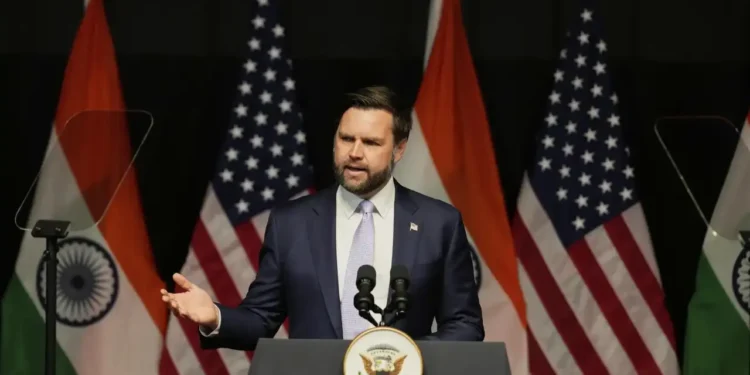In a pointed call for strengthened bilateral relations, U.S. Vice President JD Vance on Monday warned that a failure to deepen cooperation between the United States and India could result in a “very dark time for all of humanity.” His comments, delivered during a keynote address at the Rajasthan International Centre in Jaipur, were aimed at reinforcing the strategic importance of U.S.-India ties in shaping a peaceful and prosperous 21st century.
Vance, who is currently on a four-day official visit to India accompanied by his wife Usha Vance and their three children, framed the partnership between the world’s largest democracies as not just bilateral, but foundational to global stability and economic resilience.
A Vision for Economic and Strategic Cooperation
The vice president’s remarks came as the two countries move closer to a landmark bilateral trade agreement, with Vance confirming that the terms of reference for negotiations have been finalised. The agreement, he said, would address longstanding tariff barriers and unlock new economic opportunities for both nations.
“This is a moment where both sides must move quickly,” Vance said. “If India and the United States work together successfully, we’re going to see a 21st century that is prosperous and peaceful. If we don’t, the world is heading for a very different future.”
Indian Finance Minister Nirmala Sitharaman, who has been spearheading India’s side of the talks, echoed Vance’s optimism. She stated that the first phase of the agreement could be finalised by autumn, setting the stage for broader engagement across sectors ranging from digital trade to clean energy.
Praising Modi and Advancing Energy Ties
Vance praised Indian Prime Minister Narendra Modi, describing him as a “tough negotiator,” while acknowledging the role his leadership has played in enhancing U.S.-India engagement. “He has the long-term vision and the clarity required to move this relationship forward,” Vance said.
Energy was a key theme during the vice president’s address. Vance emphasized that the U.S. is prepared to ramp up energy exports to India, including liquefied natural gas (LNG) and clean energy technologies. He also urged the Indian government to address non-tariff barriers that currently hinder American businesses from entering or expanding in the Indian market.
India, the world’s third-largest oil importer, has been actively seeking to diversify its energy sources. Collaborations with the U.S. in LNG, solar technology, and strategic petroleum reserves are already underway, and Vance’s visit is expected to accelerate progress in these areas.
Cultural Diplomacy and Symbolism
Beyond the boardroom, the Vance family participated in cultural and historical engagements, including a visit to the Amer Fort in Jaipur, where they were seen interacting with local artisans and students. The visit by Usha Vance, of Indian heritage, was seen as a symbolic gesture that added warmth and familiarity to the diplomatic mission.
Observers noted that the personal dimension of the visit helped soften the otherwise strategic tone of the engagement. “It’s a blend of hard diplomacy and soft power,” said a senior official in India’s Ministry of External Affairs. “The optics are deliberate, and they are effective.”
Setting the Stage for a Presidential Visit
The outcomes of Vance’s trip are expected to lay the groundwork for President Donald Trump’s upcoming visit to India, tentatively scheduled for later this year. Officials on both sides are working to finalise deliverables that include not only trade pacts but also new frameworks for defense collaboration, counter-terrorism, and cybersecurity.
Strategic analysts see this as part of a broader U.S. effort to counterbalance China’s influence in the Indo-Pacific region, where India plays a critical role as both a regional power and a democratic partner.
A Pivotal Moment in U.S.-India Relations
As global alliances continue to evolve and new geopolitical flashpoints emerge, Vance’s appeal for greater alignment is being viewed as a pivotal moment. His stark warning of a “dark time” without cooperation was not merely rhetorical—it was a signal that Washington sees India as a core pillar of its foreign policy strategy for the coming decades.
“If we are to build a secure, democratic, and prosperous world,” Vance concluded, “there is no relationship more essential than the one between the United States and India.”
With negotiations advancing and strategic dialogue expanding, the next few months may prove decisive in redefining the contours of one of the world’s most important bilateral partnerships.








